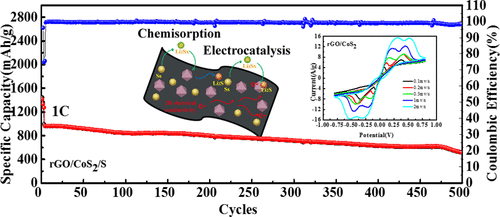当前位置:
X-MOL 学术
›
J. Phys. Chem. C
›
论文详情
Our official English website, www.x-mol.net, welcomes your
feedback! (Note: you will need to create a separate account there.)
Promoting Electrocatalytic Conversion of Polysulfide using Cobalt Disulfide Nanocrystals for Lithium Sulfur Batteries
The Journal of Physical Chemistry C ( IF 3.3 ) Pub Date : 2020-08-06 , DOI: 10.1021/acs.jpcc.0c06135 Qianqian Hu 1, 2, 3 , Biao Wang 1, 3, 4 , Jiqun Lu 1, 3 , Congcong Zhang 1, 3 , Chun Yang 1, 3, 4 , Shiyong Chang 2 , Haiyong Dong 2 , Chunyu Wu 2 , Ye Hong 5 , Lingzhi Zhang 1
The Journal of Physical Chemistry C ( IF 3.3 ) Pub Date : 2020-08-06 , DOI: 10.1021/acs.jpcc.0c06135 Qianqian Hu 1, 2, 3 , Biao Wang 1, 3, 4 , Jiqun Lu 1, 3 , Congcong Zhang 1, 3 , Chun Yang 1, 3, 4 , Shiyong Chang 2 , Haiyong Dong 2 , Chunyu Wu 2 , Ye Hong 5 , Lingzhi Zhang 1
Affiliation

|
Lithium sulfur batteries provide one of the most attractive opportunities for next generation energy storage devices benefiting from their particularly high energy density. However, the obstacle mainly originating from the sluggish conversion kinetics between the soluble lithium polysulfide immediate and S/Li2S/Li2S2 results in lithium sulfur batteries with low sulfur usage and coulombic efficiency, poor cycling, and rate performance. In this work, a new cathode host material with cobalt disulfide nanoparticles supported on reduced graphene oxides (GOs) has been designed to enhance the interactive affinity to lithium polysulfide and accelerate polysulfide conversion more effectively. With the implementation of these metal chalcogenides, a sulfur cathode with low polarization, stable cycling performance, and high rate capability is obtained. Moreover, this work offers solid evidence from the post mortem analysis of symmetric cells such as SEM and XPS, confirming the origin of the catalytic effects from cobalt disulfide nanocrystals wrapped with reduced GOs in a sulfur battery.
中文翻译:

用二硫化钴纳米晶体促进锂硫电池的多硫化物电催化转化
锂硫电池得益于其特别高的能量密度,为下一代储能设备提供了最具吸引力的机会之一。但是,该障碍主要来自可溶性多硫化锂即溶物与S / Li 2 S / Li 2 S 2之间的转化动力学缓慢。结果导致锂硫电池的硫使用量和库仑效率低,循环性能差和倍率性能差。在这项工作中,已设计了一种新的阴极主体材料,其具有负载在还原石墨烯氧化物(GOs)上的二硫化钴纳米颗粒,以增强与多硫化锂的相互作用亲和力,并更有效地加速多硫化物的转化。通过实施这些金属硫属化物,可获得具有低极化,稳定的循环性能和高倍率能力的硫阴极。此外,这项工作从对称电池(如SEM和XPS)的事后分析中提供了有力的证据,证实了硫电池中包裹有还原GO的二硫化钴纳米晶体的催化作用的起源。
更新日期:2020-10-02
中文翻译:

用二硫化钴纳米晶体促进锂硫电池的多硫化物电催化转化
锂硫电池得益于其特别高的能量密度,为下一代储能设备提供了最具吸引力的机会之一。但是,该障碍主要来自可溶性多硫化锂即溶物与S / Li 2 S / Li 2 S 2之间的转化动力学缓慢。结果导致锂硫电池的硫使用量和库仑效率低,循环性能差和倍率性能差。在这项工作中,已设计了一种新的阴极主体材料,其具有负载在还原石墨烯氧化物(GOs)上的二硫化钴纳米颗粒,以增强与多硫化锂的相互作用亲和力,并更有效地加速多硫化物的转化。通过实施这些金属硫属化物,可获得具有低极化,稳定的循环性能和高倍率能力的硫阴极。此外,这项工作从对称电池(如SEM和XPS)的事后分析中提供了有力的证据,证实了硫电池中包裹有还原GO的二硫化钴纳米晶体的催化作用的起源。











































 京公网安备 11010802027423号
京公网安备 11010802027423号